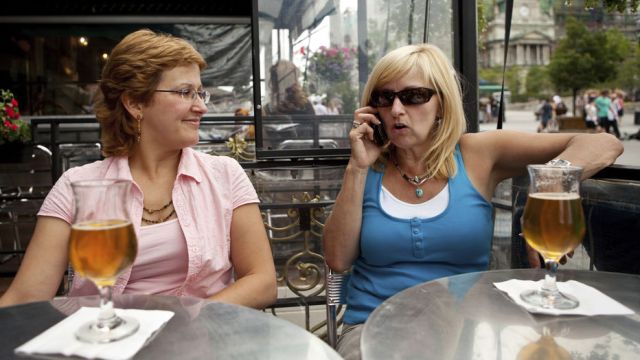When Bad Sex Work Drives out the Good

Sign up for the Smarter Faster newsletter
A weekly newsletter featuring the biggest ideas from the smartest people
I was on train last Sunday night traveling through Brussels when my 12-year-old son looked out the window and excitedly proclaimed, “They have a red light district!” He was right; the street running parallel to the train tracks was lined with women in their Christmas-box windows beckoning travelers off the train to come and enjoy their services.
Even in Paris, where sex work has not been fully legalized, my lovely boy likes to play the “I spy the sex worker” game as we walk down the street in the middle of the day.
But he doesn’t see them all.
For example, he didn’t realize that the two Romanian girls who were roughly paraded (three times!) past a café where we were having dinner last month are sex workers. Why would he? They look too young to even be in his class at school.
And he doesn’t realize that the young Black men who hang around outside the train station near our house are sex workers. Even I didn’t pick up on that one until one of them offered me his services last month while I was waiting for a friend.
Europe is a popular location for sex tourists and there appears to be a phenomena here of the bad sex work driving out the good sex work.
There is an argument that the legalization of sex work makes that occupation safer for women. It makes it possible, for example, for sex workers to work out of their homes and screen their clients in advance by advertising online. If that were the only effect of legalization, the substitution away from unsafe street work, then legalization would make sense from the perspective of making women safer.
The problem with legalization is that there is a market scale effect as well -– the legalization increases the demand for prostitutes and, in response, criminal organizations can increase their profits by increasing the supply of sex workers through the illegal importation of trafficked women.
That suggests that legalizing prostitution in order to make local sex workers safe potentially puts other women at risk — women who are not voluntarily working as sex workers but instead are there because they have been manipulated, tricked, socially isolated and violently abused into selling their bodies to sex tourists.
When there are a limited number of brothel licenses/ locations, this increase in the supply of sex workers by organized criminal elements drives up the rent that independent sex workers pay for those licenses / spaces. When cities try to crack down on organized crime by limiting those spaces further, rents for independent workers increase by even more, making it difficult for independent sex operators to continue working.
This is exactly the complaint of independent sex workers in Amsterdam where the city is in the process of closing half of the city’s 400 brothels.
The bad sex work, that by trafficked women who don’t get to see the profits of their labor, is driving out the good sex work of voluntary and independent workers.
A new working paper at the Courant Research Centre hypothesizes that legalizing prostitution has the potential to either increase or decrease human trafficking. Human trafficking could increase, for example, because of the scale effect: as the sex market expands, criminal organizations move in to sell the bodies of trafficked women. Human trafficking could decrease, though, because of a substitution effect. Legitimate business owners should favor local sex workers with permission to work legally since using illegal workers puts their business permits at risk.
The authors of this paper test their hypothesis using as their dependent variable the degree of human trafficking in a specific country, measured on a six-point scale, reported in the UNODC report on the incidence of human trafficking.
They find that the legalization of prostitution reduces the probability that a country receives no human traffic by 5.3 percentage points. They also find that the probability that it is among the second lowest group of recipient countries of trafficked sex workers falls by 10 percentage points and that it is among the third lowest group of recipient countries of trafficked sex workers falls by 8.6 percentage points.
On the other hand, they find that the legalization of prostitution increases the probability that a country is among the group of top recipients of trafficked sex workers by 1.2 percentage points, the probability that is among the second highest group of recipient countries of trafficked sex workers increases by 12.8 percentage points and the probability that it is among the third highest group of recipient countries of trafficked sex workers increases by 8.6 percentage points.
The measures are imperfect, which is always a problem when dealing with criminal activity, but this is very good evidence that legalization of prostitution increases human trafficking.
You may be surprised that I don’t do more to shelter my son from knowledge of the sex trades but personally I would rather he did not get that education from his friends as an adult. They will tell him that sex workers are really horny women who live to give men pleasure. I hear this argument all the time from readers of my blog who are sex buyers. He needs to hear directly from me that many sex workers, even in North American, are victims of trafficking. I doubt he understands the full implications of what that really means right now, but I figure that teaching him that sex workers are real people is a pretty good start.
By the way, anyone who is interested in a film that does a great job in describing how young boys from Eastern Europe (many as young as my son) end up in the sex trades and being trafficked into countries like the Netherlands, I recommend the excellent, and heartbreaking, documentary Angels but not Angels.
Reference:
Seo-Young Cho, Axel Dreher and Eric Neumayer (September 2011). “Does Legalization of Prostitution Increase Human Trafficking?” Courant Research Centre Discussion Paper Number 96.
Even in Paris, where sex work has not been fully legalized, my lovely boy likes to play the “I spy the sex worker” game as we walk down the street in the middle of the day.
But he doesn’t see them all.
For example, he didn’t realize that the two Romanian girls who were roughly paraded (three times!) past a café where we were having dinner last month are sex workers. Why would he? They look too young to even be in his class at school.
And he doesn’t realize that the young Black men who hang around outside the train station near our house are sex workers. Even I didn’t pick up on that one until one of them offered me his services last month while I was waiting for a friend.
Europe is a popular location for sex tourists and there appears to be a phenomena here of the bad sex work driving out the good sex work.
There is an argument that the legalization of sex work makes that occupation safer for women. It makes it possible, for example, for sex workers to work out of their homes and screen their clients in advance by advertising online. If that were the only effect of legalization, the substitution away from unsafe street work, then legalization would make sense from the perspective of making women safer.
The problem with legalization is that there is a market scale effect as well -– the legalization increases the demand for prostitutes and, in response, criminal organizations can increase their profits by increasing the supply of sex workers through the illegal importation of trafficked women.
That suggests that legalizing prostitution in order to make local sex workers safe potentially puts other women at risk — women who are not voluntarily working as sex workers but instead are there because they have been manipulated, tricked, socially isolated and violently abused into selling their bodies to sex tourists.
When there are a limited number of brothel licenses/ locations, this increase in the supply of sex workers by organized criminal elements drives up the rent that independent sex workers pay for those licenses / spaces. When cities try to crack down on organized crime by limiting those spaces further, rents for independent workers increase by even more, making it difficult for independent sex operators to continue working.
This is exactly the complaint of independent sex workers in Amsterdam where the city is in the process of closing half of the city’s 400 brothels.
The bad sex work, that by trafficked women who don’t get to see the profits of their labor, is driving out the good sex work of voluntary and independent workers.
A new working paper at the Courant Research Centre hypothesizes that legalizing prostitution has the potential to either increase or decrease human trafficking. Human trafficking could increase, for example, because of the scale effect: as the sex market expands, criminal organizations move in to sell the bodies of trafficked women. Human trafficking could decrease, though, because of a substitution effect. Legitimate business owners should favor local sex workers with permission to work legally since using illegal workers puts their business permits at risk.
The authors of this paper test their hypothesis using as their dependent variable the degree of human trafficking in a specific country, measured on a six-point scale, reported in the UNODC report on the incidence of human trafficking.
They find that the legalization of prostitution reduces the probability that a country receives no human traffic by 5.3 percentage points. They also find that the probability that it is among the second lowest group of recipient countries of trafficked sex workers falls by 10 percentage points and that it is among the third lowest group of recipient countries of trafficked sex workers falls by 8.6 percentage points.
On the other hand, they find that the legalization of prostitution increases the probability that a country is among the group of top recipients of trafficked sex workers by 1.2 percentage points, the probability that is among the second highest group of recipient countries of trafficked sex workers increases by 12.8 percentage points and the probability that it is among the third highest group of recipient countries of trafficked sex workers increases by 8.6 percentage points.
The measures are imperfect, which is always a problem when dealing with criminal activity, but this is very good evidence that legalization of prostitution increases human trafficking.
You may be surprised that I don’t do more to shelter my son from knowledge of the sex trades but personally I would rather he did not get that education from his friends as an adult. They will tell him that sex workers are really horny women who live to give men pleasure. I hear this argument all the time from readers of my blog who are sex buyers. He needs to hear directly from me that many sex workers, even in North American, are victims of trafficking. I doubt he understands the full implications of what that really means right now, but I figure that teaching him that sex workers are real people is a pretty good start.
By the way, anyone who is interested in a film that does a great job in describing how young boys from Eastern Europe (many as young as my son) end up in the sex trades and being trafficked into countries like the Netherlands, I recommend the excellent, and heartbreaking, documentary Angels but not Angels.
Reference:
Seo-Young Cho, Axel Dreher and Eric Neumayer (September 2011). “Does Legalization of Prostitution Increase Human Trafficking?” Courant Research Centre Discussion Paper Number 96.
Sign up for the Smarter Faster newsletter
A weekly newsletter featuring the biggest ideas from the smartest people





